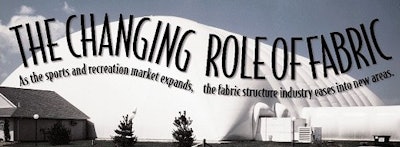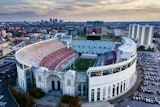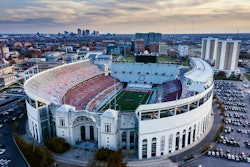As the sports and recreation market expands the fabric-structure industry eases into new areas

Manufacturers of fabric structures have long defended the viability of their "bubbles" and "tents" against the idea that they might pop or blow away in adverse weather conditions. Fabric is economical, energy-efficient and structurally sound, they say - and an effective cover or enclosure for a variety of facilities in the sports and recreation industry.
While their claims haven't changed much over the years, manufacturers are having an easier time selling their products these days.
"The fabric structure industry had a rough period in the early '90s that weeded out a lot of companies," says Jan Ligas Jr. of Air Structures American Technologies Inc. in Rye Brook, N.Y.
"But things have changed considerably and business is fantastic. I don't think anyone can complain."
Skip Reitmeier of Tensar Industries Inc. in Akron, N.Y., says the market in sports and recreation hasn't grown significantly with regard to the number of fabric structures going up, but it has shifted to accommodate new and different uses.
"Traditionally, tennis courts and swimming pools were big business, and they have dropped off somewhat. Others, like golf and soccer, are taking off," he says.
"Tennis in particular has been weak for several years," says Ligas. "The multi-recreational, soccer, roller hockey, ice hockey and golf facilities have come in and picked up the slack."
An AB survey of eight leading fabric structure manufacturers reveals that tennis facilities and pools still have a hold on the fabric business in sports and recreation, making up more than 50 percent of the market. But golf driving ranges are up-and-coming, with roughly 15 percent of the market. Multipurpose facilities, fields (including soccer, football and baseball) and hockey rinks are close behind.
In contrast with tennis, sports like soccer and golf by nature demand bigger facilities. Consequently, the fabric structures have become larger and their dollar values have risen. To accommodate the size increase, the structures have also become more sophisticated in their design.
Among the more significant improvements are the use of higher-quality fabrics, better, more efficient insulation solutions and the ability to install the structures in a shorter period of time.
"A fabric building used to normally take a week or two to put up," says LaRosa. "After some refining, it now takes just a few days."
For air-supported structures, more technologically advanced mechanicals are offered. "Our control packages are totally computerized," says Peter Donoghue of Yeadon Fabric Domes Inc. in Minneapolis. "You can sit at home with a laptop and run them. That hasn't been an option until now."
The structures themselves continue to improve, but what manufacturers find even more important is that fabric is being used by more and more professionals. "Architects and engineers are very much involved in the design of them," says Donoghue. "The fabric structure has come out of its ugly duckling stage and become more aesthetically and architecturally acceptable."
The increased involvement of facility designers has led to an increase in fabric structures in a number of markets. The companies surveyed all cater in great part to the sports and recreation industry, but they also provide structures for other applications, such as casinos, hotels, trade shows, construction sites, retail businesses and churches.
"Fabric is gaining recognition in a plethora of marketplaces," says Jeff Williams of Universal Fabric Structures Inc. in Quakertown, Pa. "We do quite a brisk hazardous-waste business, for example. Another manufacturer does good business in agricultural markets. Then there are the big players that do projects like the Denver International Airport."
Manufacturers agree this growth has helped create a more mature, self-perpetuating industry that offers more opportunities for potential buyers to experience the products.
"It's one thing to see a picture of a fabric structure, but you have to get inside one to realize how well they work," says Steve Bielski of Air Structures Inc. in Sacramento, Calif. "Five years ago, there probably wasn't a fabric structure in the whole state of Montana. Once they got one, people could actually see it and touch it. Now they have three or four. That exposure is key to building this industry."
For that reason, FBS Quik-Span (formerly Fabric Building Systems Inc.) in Weed, Calif., offers its customers a small demo unit to have on-site for future users to examine. "There is no better salesperson than a product demonstration," says Tony LaRosa of FBS. "It's like that with any business. If people can't kick the tires and drive it around the block, they might not buy it."
Fabric structure manufacturers are also realizing a shift away from private sector use of their products. According to AB's survey, private facilities and health clubs are still the primary buyers, with about 60 percent of the market, but colleges and universities are showing considerably more interest.
Colleges have generally used fabric structures for larger stadium and arena projects, as well as for practice facilities. But in an age in which college sports more than ever mimic professional sports, there's tremendous need for additional practice facilities.
"As the seasons get longer, the more institutions see the need for indoor fields, especially in areas like the Midwest where the weather is lousy," says Bielski. "If a football team can practice year-round, they may get a better shot at a bowl game, which can mean millions of dollars for the team. That's enough to cover the whole athletic program for some schools."
Fabric practice facilities can also be found at some high schools, although that market has seen slow growth. One reason for high schools' resistance to fabric structures is the age of the user group.
"There are kids who will goof off and throw pencils or other objects at the fabric and try to rip it," says LaRosa. "That has concerned a lot of administrators and caused them to shy away from the idea."
Municipalities, YMCAs and JCCs have also had a minimum of growth (these groups have also been slow to commit because they are often hindered by lack of funds), but manufacturers say the inquiries coming in from these groups are just now making an impression.
"I'm getting calls on in-line hockey arenas, climbing walls and even camps," says LaRosa. "I have a prospect who wants to extend a summer camp into the spring and fall, so he's looking for something with a tent appearance, but in a size that can accommodate group activities."
More manufacturers are looking to help with money matters by offering a leasing option. Depending on the company, rental-type leases and lease-to-own agreements are available through inhouse or third-party lenders. "There are a lot of start-ups in the recreation industry, and they are sometimes hard to find financing for," says Williams. "But we do what we can, depending on our abilities and those of the client."
Manufacturers continue to add these kinds of services to make their products even more attractive to buyers. Some companies that offer frame-supported structures are offering modular buildings that are easily expanded or reduced. One manufacturer, Universal Fabric, is providing full project management services. "We'll do everything from the pouring of the concrete to the hooking up of the lights to the permits," says Williams.
Because the fabric structure industry is not very big, as Ligas says, each small step is important to improving business. It also means, however, that it is just as easy to set the industry back.
"The stigma we've battled all these years - it's still out there," says Ligas. "In my opinion, there are still companies that take advantage of antiquated building codes that do not reflect the proper snow loads, wind loads and safety factors that fabric structures demand. When accidents happen, everyone gets a black eye. So it's up to the reputable companies out there to regulate themselves and keep doing it the right way."
"This is definitely not a business where you can open the door and become an instant success," says Donoghue. "It takes a long time for people to test and gain confidence in this kind of product. But to our benefit, I've been in this business seven years and it doesn't at all resemble what it was. The fabric structure industry has changed completely, for the better."




































